 |
 |
 |
 |
 |
 |
| |
 |
|
 |
 |
 |
  |
  |
 |
 |
 |
 |
|
|
 |
|
 |
 |
 |
BUILDING |
 |
|
 |
|
 |
 |
 |
| |
 |
| 
 |
SFMOMA - San Francisco Museum of Modern Art
Extension |
|
 |
 |
 |
 |
DESIGNER |
 |
|
|
 |
|
 |
 |
 |
| |
 |
|
 |
 |
 |
 |
CONTEXT |
 |
|
|
 |
|
 |
 |
 |
| Relationship with the location |
 |
|
 |
SFMOMA’s leadership worked closely with Snøhetta to design the new museum as an outward- looking and engaging gathering space. Connections to the surrounding neighborhood and city were carefully considered, along with bringing the benefits of landscape and the outdoors to the museum spaces. New pedestrian pathways around the museum and a new public entrance on Howard Street better integrate SFMOMA into the South of Market (SoMa) neighborhood and activate the surrounding streetscape.
|
|
 |
 |
 |
 |
 |
 |
 |
DESCRIPTION |
 |
|
|
 |
|
 |
 |
 |
| . |
 |
|
 |
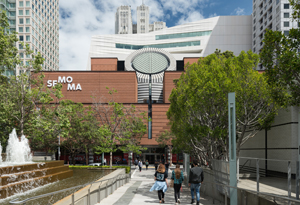 The project was conceived to create a more open and welcoming SFMOMA, with the volume of the expansion rising up behind the Botta building and stretching the full city block from Minna Street to Howard Street. This placement activates existing mid-block streets as pedestrian pathways and opens up new entrances, deeply integrating the museum into the South of Market (SoMa) neighborhood, including nearby Yerba Buena Gardens and the Moscone Center. The project was conceived to create a more open and welcoming SFMOMA, with the volume of the expansion rising up behind the Botta building and stretching the full city block from Minna Street to Howard Street. This placement activates existing mid-block streets as pedestrian pathways and opens up new entrances, deeply integrating the museum into the South of Market (SoMa) neighborhood, including nearby Yerba Buena Gardens and the Moscone Center.
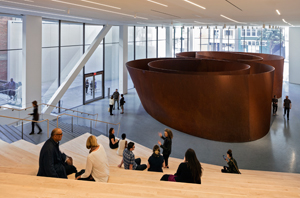 Two entrances on Third and Howard Streets connect visitors to free ground-floor exhibition spaces, inaugurated with a presentation of Richard Serra’s monumental sculpture Sequence (2006) in the Roberts Family Gallery, where the museum will present commissioned works in the future. The Joyce and Larry Stupski Entrance at Minna Street welcomes school groups to the Koret Education Center, as well as visitors attending in the Phyllis Wattis Theater and the Gina and Stuart Peterson White Box. Two entrances on Third and Howard Streets connect visitors to free ground-floor exhibition spaces, inaugurated with a presentation of Richard Serra’s monumental sculpture Sequence (2006) in the Roberts Family Gallery, where the museum will present commissioned works in the future. The Joyce and Larry Stupski Entrance at Minna Street welcomes school groups to the Koret Education Center, as well as visitors attending in the Phyllis Wattis Theater and the Gina and Stuart Peterson White Box.
The pathways from all three public entrances converge at the second-floor Helen and Charles Schwab Hall, a spacious gathering place with views to the Pat and Bill Wilson Sculpture Terrace and the museum’s new vertical garden, the largest public living wall of native plants in the United States. In Helen and Charles Schwab Hall, visitors may pass from the free ground-floor exhibition spaces into the second-floor and upper floors of ticketed galleries for the permanent collection and special exhibitions. |
|
 |
 |
 |
|
 |
|
| A Transformed Home for SFMOMA |
 |
|
 |
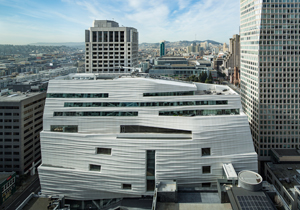 Craig Dykers, founding partner of Snøhetta and leader of the firm’s design team for SFMOMA, said, “Our design seeks to create an intimate experience, welcoming a diversity of visitors to the magnificent collection, and fostering a connection between the visitor and museum for years to come. All of the senses will be engaged as part of the experience. Wonderful day lit staircases lead visitors from floor to floor, the galleries create a comfortable viewing experience of the art, and terraces allow for moments of repose, to be reinvigorated by fresh air, sunlight and vistas of the city between galleries. The visitor should sense that the building is inspired by one of the great cities of the world, San Francisco.” Craig Dykers, founding partner of Snøhetta and leader of the firm’s design team for SFMOMA, said, “Our design seeks to create an intimate experience, welcoming a diversity of visitors to the magnificent collection, and fostering a connection between the visitor and museum for years to come. All of the senses will be engaged as part of the experience. Wonderful day lit staircases lead visitors from floor to floor, the galleries create a comfortable viewing experience of the art, and terraces allow for moments of repose, to be reinvigorated by fresh air, sunlight and vistas of the city between galleries. The visitor should sense that the building is inspired by one of the great cities of the world, San Francisco.”
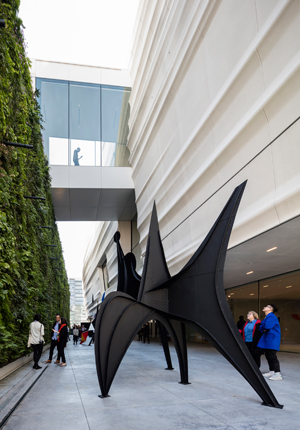 Visitors are welcomed to the new museum by two main entrances, leading to ground floor exhibition spaces that are free to all. The entrance on Third Street welcomes visitors to the reimagined Evelyn and Walter Haas, Jr. Atrium, where the iconic oculus floods the space with natural light. Alexander Calder’s 27-foot-wide mobile, Untitled (1963), is suspended beneath the oculus, drawing the eye upwards, and a new sculptural stair leads visitors to Helen and Charles Schwab Hall, the main gathering space on the second floor. Visitors are welcomed to the new museum by two main entrances, leading to ground floor exhibition spaces that are free to all. The entrance on Third Street welcomes visitors to the reimagined Evelyn and Walter Haas, Jr. Atrium, where the iconic oculus floods the space with natural light. Alexander Calder’s 27-foot-wide mobile, Untitled (1963), is suspended beneath the oculus, drawing the eye upwards, and a new sculptural stair leads visitors to Helen and Charles Schwab Hall, the main gathering space on the second floor.
On Howard Street, a new museum entrance adjacent to the glass-walled Roberts Family Gallery, allows visitors to enter the museum through Schwab Hall. Now presenting Richard Serra’s monumental sculpture Sequence (2006), the Roberts Family Gallery is a vibrant space visible to passersby, creating a visual connection between the city and the museum and showcasing SFMOMA’s community-focused mission. Inside, a set of maple-faced Roman steps provides an informal public gathering spot and seating area.
From both entrances, stairs lead visitors to Schwab Hall, the hub of the new museum. Visitors can enjoy a rotating installation of artworks, such as Sol LeWitt’s joyful Wall Drawing 895: Loopy Doopy (white and blue) (1999), or obtain admission to explore the rest of the museum. From here, a maple- clad stair leads upward to the third-floor Pritzker Center for Photography and the galleries above.
The new galleries in the Snøhetta-designed expansion are intimate in scale and create ideal conditions for viewing the artworks. Diverse gallery spaces support the display of specific collections and works of various scales. Minimal, flexible, column-free galleries permit countless temporary wall layouts—a blank canvas for the curators. At opening, visitors can experience a contemplative, octagonal-shaped gallery devoted to seven works by Agnes Martin and loft-like galleries on the seventh floor that offer space for contemporary artworks.
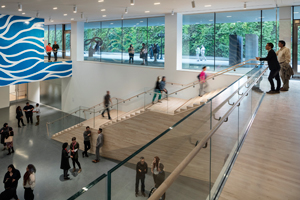 Terraces adjacent to many galleries extend exhibitions into the city, displaying outdoor sculptures and offering unparalleled views of San Francisco. The new third-floor Pat and Bill Wilson Sculpture Terrace is home to the largest public living wall in the United States with more than 19,000 plants and 21 native species. This curated sequence of spaces allows visitors to move between incredible artworks to broad overlooks, and enjoy views of the city as they circulate through and up the museum. Terraces adjacent to many galleries extend exhibitions into the city, displaying outdoor sculptures and offering unparalleled views of San Francisco. The new third-floor Pat and Bill Wilson Sculpture Terrace is home to the largest public living wall in the United States with more than 19,000 plants and 21 native species. This curated sequence of spaces allows visitors to move between incredible artworks to broad overlooks, and enjoy views of the city as they circulate through and up the museum.
Complementing the museum’s incredible art galleries, the new SFMOMA features dynamic educational program and performances. The new Koret Education Center serves students, teachers and lifelong learners with a resource library and studio classrooms. SFMOMA partnered with Bay Area innovator Meyer Sound to install sound solutions throughout the museum, including a state-of-the-art Constellation acoustic system in the newly renovated Phyllis Wattis Theater. The Wattis Theater screens archival film and offers cutting-edge 4K projection. The new Gina and Stuart Peterson White Box is a uniquely flexible space, with a theatrical truss that supports a variety of performances, events or large scale artworks. |
|
 |
 |
 |
|
 |
|
| SFMOMA Collection and Inaugural Exhibitions |
 |
|
 |
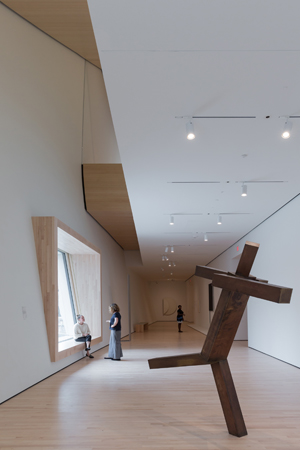 SFMOMA is one of the foremost museums of modern and contemporary art, with an exemplary collection of more than 33,000 works of architecture and design, media arts, painting, photography and sculpture, as well as a groundbreaking 100-year partnership to show the Doris and Donald Fisher Collection, one of the world’s greatest private collections of postwar and contemporary art. Among the 260 selections on view from the Fisher Collection at the opening are important works of American abstraction, Pop, Minimal and figurative art by artists such as Chuck Close, Ellsworth Kelly, Lee Krasner, Roy Lichtenstein, Agnes Martin and Andy Warhol; works of German art after the 1960s by such artists as Sigmar Polke and Gerhard Richter; a broad range of Alexander Calder works from the late 1920s to the late 1960s; and sculpture by leading British artists including Tony Cragg, Richard Deacon, Barbara Hepworth and Richard Long. SFMOMA is one of the foremost museums of modern and contemporary art, with an exemplary collection of more than 33,000 works of architecture and design, media arts, painting, photography and sculpture, as well as a groundbreaking 100-year partnership to show the Doris and Donald Fisher Collection, one of the world’s greatest private collections of postwar and contemporary art. Among the 260 selections on view from the Fisher Collection at the opening are important works of American abstraction, Pop, Minimal and figurative art by artists such as Chuck Close, Ellsworth Kelly, Lee Krasner, Roy Lichtenstein, Agnes Martin and Andy Warhol; works of German art after the 1960s by such artists as Sigmar Polke and Gerhard Richter; a broad range of Alexander Calder works from the late 1920s to the late 1960s; and sculpture by leading British artists including Tony Cragg, Richard Deacon, Barbara Hepworth and Richard Long.
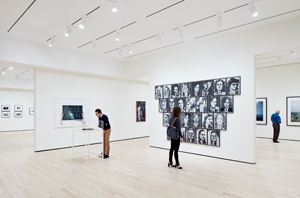 Supported by a strong community of collectors, SFMOMA also has received more than 3,000 promised and outright gifts of artworks from 230 donors through the Campaign for Art. The inaugural exhibitions highlight the range and quality of 600 of these newly committed and acquired modern and contemporary works, including special installations focused on photography, contemporary art and drawing. Supported by a strong community of collectors, SFMOMA also has received more than 3,000 promised and outright gifts of artworks from 230 donors through the Campaign for Art. The inaugural exhibitions highlight the range and quality of 600 of these newly committed and acquired modern and contemporary works, including special installations focused on photography, contemporary art and drawing.
Photography has long been a cornerstone of SFMOMA, and the new Pritzker Center for Photography, made possible by the Lisa and John Pritzker Family Fund, offers the largest exhibition, interpretation and study space dedicated to photography in any art museum in the United States. The inaugural exhibition in the Pritzker Center’s permanent collection galleries includes works drawn from the museum’s collection illustrating photography’s complex and ever-changing relationship with time by artists such as Dawoud Bey, Julia Margaret Cameron, Henri Cartier-Bresson and Phil Chang.
SFMOMA’s vibrant commissioning program is being inaugurated in the new museum with a site- specific textile mural by Dutch designer Claudy Jongstra. New galleries dedicated to the art and artists of California underscore SFMOMA’s commitment to artists of the Bay Area and beyond, including David Ireland, Lynn Hershman Leeson and Wayne Thiebaud, in addition to artworks by California artists integrated throughout the museum. Architecture and design exhibitions on view at opening explore the lineage of graphic design, as well as the process behind Snøhetta’s design for the new SFMOMA. A thematic media arts presentation centering on the notion of place presents works by five artists, including a surveillance-based installation by artist Julia Scher that has been conceived and adapted for each of SFMOMA’s sites using evolving technologies from 1993 to 2016. In addition, the first of a series of installations focused on selections from SFMOMA’s permanent collection provides fresh perspectives on cherished works, such as Henri Matisse’s Femme au chapeau (Woman with a Hat) (1905) and Mark Rothko’s No.14, 1960 (1960), among others. |
|
 |
 |
 |
|
 |
|
| Digital Engagement |
 |
|
 |
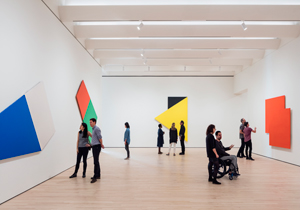 SFMOMA’s reinvented digital program, generously supported by Bloomberg Philanthropies, offers accessible, interactive experiences that break down the boundaries between art, entertainment and learning. The museum’s new app includes immersive phone-in-pocket audio journeys through the galleries, with brief reflections and fresh perspectives on artworks by composers, comedians, artists, playwrights and others; and a series of audio walks through San Francisco’s urban fabric, beginning inside the building and moving out into the SoMa neighborhood. SFMOMA’s reinvented digital program, generously supported by Bloomberg Philanthropies, offers accessible, interactive experiences that break down the boundaries between art, entertainment and learning. The museum’s new app includes immersive phone-in-pocket audio journeys through the galleries, with brief reflections and fresh perspectives on artworks by composers, comedians, artists, playwrights and others; and a series of audio walks through San Francisco’s urban fabric, beginning inside the building and moving out into the SoMa neighborhood.
The museum is incorporating digital tools into participatory learning environments, such as the Photography Interpretive Gallery, generously supported by the McEvoy Family, in the Pritzker Center for Photography, and two interactive spaces in the painting and sculpture galleries, which feature touch screens and digital tables that allow visitors to explore artworks and the careers of artists more deeply. Photography Interpretive Gallery exhibits are supported by Bank of the West. Additional support is provided by Nion McEvoy; a major grant from the National Endowment for the Humanities: Exploring the Human Endeavor; and the Institute of Museum and Library Services. |
|
 |
 |
 |
|
 |
|
| New Galleries and Spaces |
 |
|
 |
The expansion provides galleries well-tailored to the collections on view, and the gallery design rigorously eliminates visual clutter and emphasizes simplicity. Special areas within the expansion include designated spaces for:
- Pritzker Center for Photography (Floor 3)
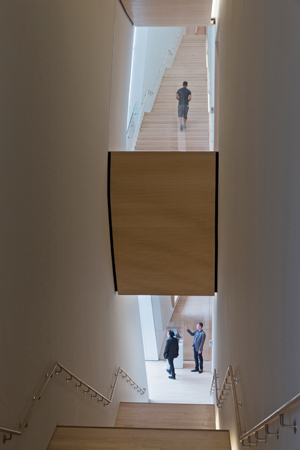 Made possibly by the Lisa and John Pritzker Family Fund, 15,000 square feet of gallery, study and interpretive space—the largest gallery and interpretive space in a U.S. art museum permanently dedicated to photography Made possibly by the Lisa and John Pritzker Family Fund, 15,000 square feet of gallery, study and interpretive space—the largest gallery and interpretive space in a U.S. art museum permanently dedicated to photography
- Doris and Donald Fisher Collection Galleries (Floors 3, 4, 5, 6)
60,000 square feet of gallery space on three floors (4, 5, 6) dedicated to selections from one of the most outstanding collections of postwar and contemporary art in the world, as well as an additional gallery on the third floor dedicated to works by Alexander Calder from the Fisher Collection, generously supported by Barbara and Gerson Bakar
- Mimi and Peter Haas Galleries (Floor 7)
8,800 square feet showcasing a rotating selection of contemporary art in a loft-like gallery, framed by extensive city views from the adjacent outdoor terrace
Architecture and Design (Floors 3, 6)
Two galleries providing 3,500 square feet dedicated to the museum’s important holdings of architecture and design, as well as special exhibitions
Two galleries providing 4,400 square feet of gallery space reserved for rotating and special exhibitions from the museum’s media arts collection, furthering SFMOMA’s commitment to
San Francisco Museum of Modern Art Architectural Fact Sheet 2 the field, generously supported by Pamela and Richard Kramlich and Jan Shrem and Maria Manetti Shrem
A 1,100-square-foot gallery, generously supported by Frances and John Bowes, permanently dedicated to showcasing emerging artists selected by the museum’s four curatorial departments
- Koret Education Center (Floor 2)
A 4,800-square-foot education center including a resource library and two classrooms. Accessible through a specially reconfigured entrance on Minna Street, the Center will serve 55,000 K-12 school children annually
- Performances and Events (Floors 1, 2, 4, 5)
The Gina and Stuart Peterson White Box, a flexible, double-height space, along with the museum’s upgraded Phyllis Wattis Theater provide locations for a wide range of performances and events
- Elise S. Haas Conservation Studio (Floors 7, 8)
A new two-story, 4,200-square-foot conservation center, adjacent to exhibition galleries with exceptional natural light, reveals to the public some of the museum’s vital work in this field, while also providing a studio space for artists
- Library and Archives (Lower Level)
A new 4,000-square-foot space for the museum’s extensive library and archives, containing nearly 250,000 objects, available to scholars and researchers by appointment
- Administrative Offices (Floors 8, 9, 10)
Office space for the museum’s administrative staff |
|
 |
 |
 |
|
 |
|
| Special Features |
 |
|
 |
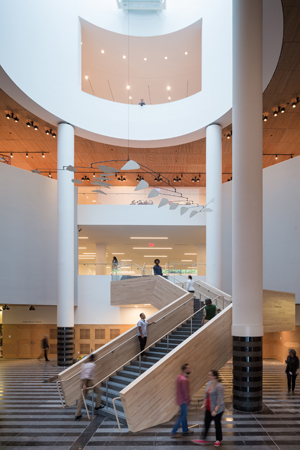 The façade of the Snøhetta expansion, inspired in part by the fog and the waters of the San Francisco Bay, comprises more than 700 uniquely-shaped FRP (fiberglass-reinforced polymer) panels affixed to a curtain-wall system to create rippling horizontal bands which appear to shift in appearance with the changing light. The façade of the Snøhetta expansion, inspired in part by the fog and the waters of the San Francisco Bay, comprises more than 700 uniquely-shaped FRP (fiberglass-reinforced polymer) panels affixed to a curtain-wall system to create rippling horizontal bands which appear to shift in appearance with the changing light.
- The maple-faced Roman steps in the Roberts Family Gallery, overlooking Richard Serra’s monumental work, Sequence (2006), offer one of San Francisco’s liveliest new public gathering places.
- A new sculptural staircase designed by Snøhetta leads visitors from the Evelyn and Walter Haas, Jr. Atrium to the second floor. Located beneath Botta’s iconic oculus and Alexander Calder’s mobile Untitled (1963), it replaces the original 1995 stair. Opening up the space, the new, sculptural stair helps make a seamless connection between the existing and new buildings and accommodates the occupancy needs of the expanded museum.
- Six outdoor terraces provide spaces for installations of sculpture, and from the seventh floor highlight a dramatic view of the San Francisco cityscape.
- The largest public living wall in the United States provides a background for sculpture on the third floor terrace. With over 19,000 plants, including 21 plant species native to California and the Bay Area, the living wall is an ever-changing work of natural art supported with a recycled water system.
- SFMOMA has partnered with Bay Area innovator Meyer Sound to install sound solutions throughout the museum, including a state-of-the-art Constellation acoustic system in the newly renovated Phyllis Wattis Theater. Constellation provides the space with the utmost flexibility and intelligibility, establishing Wattis Theater as a premier arts venue in the Bay Area.
|
|
 |
 |
 |
 |
 |
 |
 |
VIDEO |
 |
|
|
 |
|
 |
 |
 |
| |
 |
|
 |
 |
 |
 |
MATERIALS |
 |
|
|
 |
|
 |
 |
 |
 |
 |
|
fiberglass 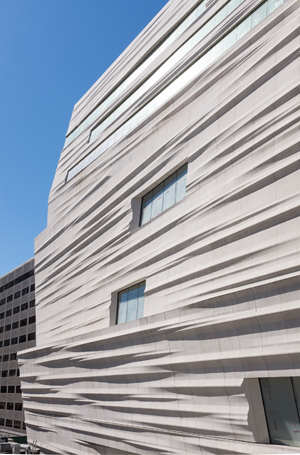 The iconic eastern façade of the Snøhetta-designed expansion, inspired in part by the waters and fog of the San Francisco Bay, is comprised of more than 700 uniquely shaped and locally fabricated FRP (fiberglass reinforced polymer) panels. The iconic eastern façade of the Snøhetta-designed expansion, inspired in part by the waters and fog of the San Francisco Bay, is comprised of more than 700 uniquely shaped and locally fabricated FRP (fiberglass reinforced polymer) panels.
Throughout the day, the movement of light and shadow naturally animates the rippled surface. Silicate crystals from Monterey County embedded in the surface catch and reflect the changing light.
|
|
 |
 |
 |
 |
ECO-SUSTAINABILITY |
 |
|
|
 |
|
 |
 |
 |
|
|
 |
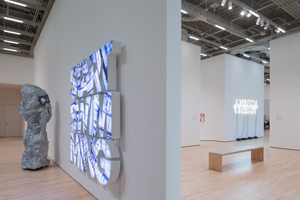 The museum is on track to receive LEED Gold certification for the new building, with a 46% reduction in energy use and a 60% decrease in potable water use. The museum is on track to receive LEED Gold certification for the new building, with a 46% reduction in energy use and a 60% decrease in potable water use.
SFMOMA is one of the first museums in the country to employ all LED lighting throughout the gallery spaces. This measure helped the museum meet its ambitious sustainability goals. |
|
 |
 |
 |
 |
 |
 |
 |
LOCATION |
 |
|
|
 |
|
 |
 |
 |

|
 |

|
Continent |
|
 |
  North America |
|
Nation |
|
 |
  United States |
|
State |
|
 |
  California |
|
County |
|
 |
  San Francisco |
|
Town |
|
 |
  San Francisco |
|
Address |
|
 |
  151 Third Street
|
|
|
|
 |
|
Website |
|
 |
|
 |
 |
 |
 |
MAP |
 |
|
|
 |
|
 |
 |
 |
| |
 |
|
 |
 |
 |
 |
|
TYPOLOGY |
 |
|
|
 |
|
 |
 |
 |
Main |
 |
|
 |
ARCHITECTURE | Buildings for cultural activities
Art galleries and exhibition areas
Museums and buildings for exhibitions
Art museums
Operations on existing buildings
Extension, superelevation
| |
|
|
 |
|
Additional |
 |
|
 |
ARCHITECTURE | Commercial buildings
Shops
Bars, cafeterias
Restaurants
| |
 |
 |
 |
 |
CHRONOLOGY |
 |
|
|
 |
|
 |
 |
 |
Project |
 |
|
 |
| 
 |
2010 - 2011
project winner of competition
|
|
Realisation |
 |
|
 |
| 
 |
2013 - 2016 |
|
 |
 |
 |
 |
BIBILIOGRAPHIC REFERENCES |
 |
|
|
 |
|
 |
 |
 |
|
 |
| Cécile Brunengo, "Extension traversante pour le SFMoMA / SFMoMA: a cross-cutting extension", L'Architecture d'Aujourd'hui 410, décembre/december 2015, p. 21 |
|
|
| Sara Johnson, "SFMØMA", Architect 12/2013, december 2013, "Front" p. 25 |
|
|
| "Snøhetta unveils SFMOMA expansion details", Architectural Record 1/2012, january 2012, p. 26 |
|
|
| "On the boards", Architectural Record 7/2011, july 2011, p. 26 |
|
|
| Peter James, "Snøhetta Tapped to Design SFMOMA Expansion", Architect 8/2010, august 2010, "news" p. 13 |
|
 |
 |
 |
 |
 |
 |
 |
CLIENT |
 |
|
|
 |
|
 |
 |
 |
| |
 |
| SFMOMA - San Francisco Museum of Modern Art |
|
 |
 |
 |
 |
AMOUNT |
 |
|
|
 |
|
 |
 |
 |
| |
 |
|
 |
 |
 |
 |
DIMENSIONAL
DATA |
 |
|
|
 |
|
 |
 |
 |
| Surface |
 |
|
 |
Total sq.m. 42,735 (sq.ft. 460,000)
Botta building sq.m. 20,903 (sq.ft. 225,000)
Snøhetta expansion sq.m. 21,832 (sq.ft. 235,000)
Total Gallery Space sq.m. 15,794 (sq.ft. 170,000)
Gallery Space Indoor sq.m. 13,564 (sq.ft. 146,000)
Gallery Space Outdoor sq.m. 2,230 (sq.ft. 24,000)
Public Access/Free Space sq.m. 3,995 (sq.ft. 43,000)
Education Space sq.m. 1,208 (sq.ft. 13,000)
Performance/Event Space sq.m. 3,437 (sq.ft. 37,000)
Conservation Lab sq.m. 372 (sq.ft. 4,000)
Museum Store sq.m. 557 (sq.ft. 6,000)
Restaurant/Dining sq.m. 1,208 (sq.ft. 13,000) |
|
 |
 |
 |
 |
STRUCTURES |
 |
|
|
 |
|
 |
 |
 |
| |
 |
| Magnusson Klemencic Associates |
|
 |
 |
 |
 |
LANDSCAPE DESIGN |
 |
|
|
 |
|
 |
 |
 |
| |
 |
|
 |
 |
 |
 |
STAFF |
 |
|
|
 |
|
 |
 |
 |
Associate designers  |
 |
|
|
 |
|
Principal-in-charge |
 |
|
Project architect |
 |
| Aaron Dorf, Lara Kaufman, Jon McNeal |
|
Project development |
 |
| Simon Ewings, Alan Gordon, Marianne Lau, Elaine Molinar, Kjetil Trædal Thorsen |
|
Design team |
 |
| Nick Anderson, Behrang Behin, Sam Brissette, Chad Carpenter, Michael Cotton, Aroussiak Gabrielian, Kyle Johnson, Nick Koster, Mario Mohan, Neda Mostafavi, Anne-Rachel Schiffmann, Carrie Tsang, Giancarlo Valle |
|
Associate architect |
 |
EHDD
Duncan Ballash (Principal + President)
Lotte Kaefer (Project Architect)
Rebecca Sharkey (Project Manager) |
|
Project management |
 |
TJ Reagan, Inc.
Terry Reagan, Don Young, Bob Reuter |
|
Audiovisual design |
 |
|
Civil engineer |
 |
|
Lab and art storage design |
 |
| Samuel Anderson Architects |
|
Electrical engineer |
 |
| The Engineering Enterprise |
|
Mechanical engineer |
 |
|
Acoustical consultant |
 |
|
Computerization |
 |
|
Facades |
 |
| The Engineering Enterprise |
|
Facades consultant |
 |
|
Engineering |
 |
| ARUP (Lighting, Acoustics, AV and Façade Engineers) |
|
Vertical transportation |
 |
|
Sustainability |
 |
|
Furniture |
 |
|
Exhibition design |
 |
Aidlin Darling Design (In Situ restaurant design)
Shopworks Design, EHDD (Museum Store design)
Boor Bridges Architecture (Sightglass at SFMOMA coffee bar design) |
|
Theatre consultant |
 |
Auerbach Pollock Friedlander (Phyllis Wattis Theater consultant)
EHDD (Phyllis Wattis Theater and Gina and Stuart Peterson White Box design architect) |
|
Graphics and signage |
 |
|
Consultant |
 |
| Habitat Horticulture and Hyphae Design Lab (Living Wall consultant) |
|
Fire safety |
 |
|
Safety coordination |
 |
|
General contractor |
 |
|
Contractor |
 |
Plant Construction Company
KASA Partners |
|
 |
 |
 |
 |
ANNOTATIONS |
 |
|
|
 |
|
 |
 |
 |
| |
 |
Architectural firms shortlisted in the competion:
- Adjaye Associates
- Diller Scofidio + Renfro
- Foster + Partners
- Snøhetta

other dossiers on SFMOMA |
|
 |
 |
 |
 |
CREDITS |
 |
|
|
 |
|
 |
 |
 |
| |
 |
Photos © Iwan Baan, Henrik Kam, Jon McNeal, Joe Fletcher
Text edited by SFMOMA
Courtesy of SFMOMA, Snøhetta
|
|
 |
  |
 |
|
|